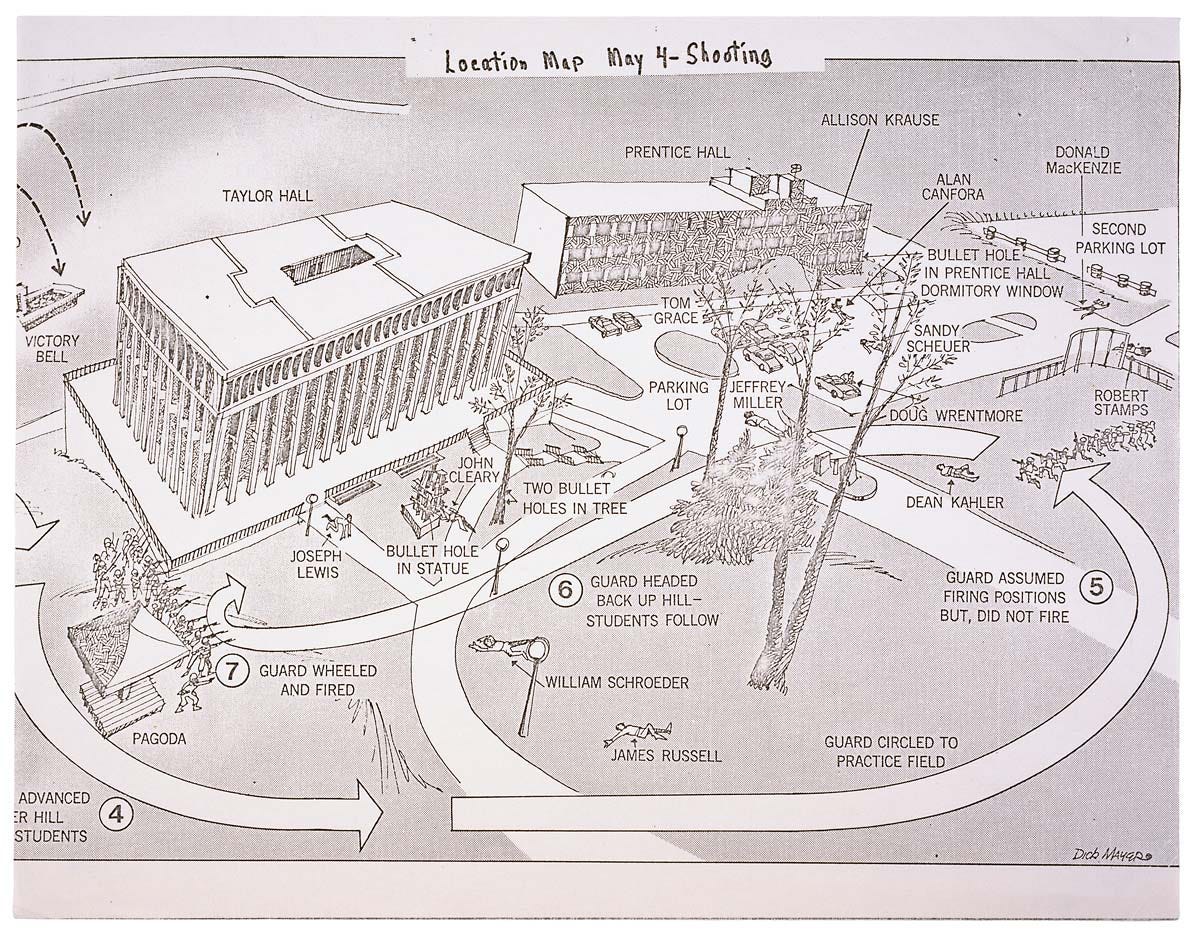Four Dead in Ohio and a Primal Scream of Rebellious Anguish
Thirteen seconds of gunfire ignited a counterculture anthem of the Vietnam War era
In 1977, for my college freshman English class, I wrote a term paper inspired by an antiwar song from 1970. As a college-aged kid, I wanted to understand how two nineteen-year-old and two twenty-year-old students died on a midwestern campus.
Kent State University in Ohio is a typical, all-American institution of higher education, attended by roughly 20,000 students. On May 1, 1970, a few hundred students gathered to protest the escalation of the Vietnam war into Cambodia.
University officials ordered the rally to disperse, thus resulting in a spillover into the nighttime bars of Kent town. Rowdy students and sympathizers vented their anger on the streets, as townspeople worried about lawlessness and broken storefronts. The mayor declared an emergency and closed down the bars.
The next day, as rumors and threats of vandalism ran rampant, city officials asked the governor to send in the Ohio National Guard troops to protect merchant properties. The soldiers arrived later in the night after protesters spent the day gathering on campus grounds and setting fire to the ROTC military building.
On May 3, the mayor imposed a curfew to keep students and local agitators from disturbing the peace. During the 1960s, American society was deeply divided into two main classes: Unruly and unpatriotic hippies and business class capitalists. The mayor called the students “un-American” and “revolutionaries” and blamed outside militant groups for fomenting trouble.
That night, another rally on the Kent State campus led to Guardsmen using tear gas to disperse students violating curfew regulations and corral them back to the dorms.
After the weekend skirmishes, the previously planned rally for Monday, May 4 at noon, generated an estimated 1,200 people arriving on the university Commons area. The protest was more organic than organized. Outrage doesn’t require preparation, it only seeks out a cohort of like-minded individuals.
Guardsmen tried to disperse the unconnected crowd using tear gas and moved into different attack positions along the protesters perimeter. What happened next is in question. But the utter chaos and confusion set the stage for a catastrophe.
In the aftermath, the statistics tell a gruesome story:
Four Kent State University students died on May 4
Nine Kent State University students were wounded
Twenty-eight National Guard soldiers fired 67 rounds of ammunition
Out of a total of 77 Guardsmen, 29 claimed to have fired their weapon
The volley of bullets lasted only 13 seconds (or up to possibly a minute, according to one eyewitness report)
By the time I made my way to where I could see them it was still unclear what was going on. The guardsmen themselves looked stunned. We looked at them and they looked at us. They were just kids, 19 years old, like us. But in uniform. Like our boys in Vietnam.
— Chrissie Hynde, Kent State student, lead singer of The Pretenders
A Protest Song Arises
In 1970 there was no Internet, no Twitter and no smartphones for texting. News moved at the speed of nightly TV broadcasts, daily radio shows and monthly magazines.
Pictures of the Kent State shooting in Life Magazine provoked Neil Young to write the lyrics to Ohio. Within weeks of the incident, Crosby, Stills, Nash & Young recorded the song and rushed it out to the national radio airwaves. They even disregarded the new song’s impact on their current hit single, Teach Your Children, already rising in the charts.
Kent State was different. It shook the nation. Young adults were losing their lives in foreign lands, not on home soil while walking on campus in-between class times.
Remember, everything in America is related to politics. The hard-hitting lyrics of Ohio challenged the Nixon Administration and the establishment.
Tin soldiers and Nixon coming … Soldiers are cutting us down.
Commercial AM radio stations banned the song from their playlist; while, FM radio stations, associated with college towns and liberal cities, kept the song going strong.
These were tumultuous times: LSD tripping and anti-establishment sentiment, a decade of pointless deaths in Vietnam, and 1972 was a reelection year for President Nixon. At the end of the song, CSNY channels the anguish of a youthful nation:
Four dead in Ohio
Four dead in Ohio (Four dead)
Four dead in Ohio (Four)
Four dead in Ohio (How many?)
Four dead in Ohio (How many more?)
Four dead in Ohio (Why?)
Four dead in Ohio (Oh!)
Four dead in Ohio (Four)
Four dead in Ohio (Why?)
Four dead in Ohio (Why?)
A Rock ‘n’ Roll Remembrance
After 50 years, Kent State is embedded in my memory. I’ve never forgotten May 4 or the names of the four students killed on the grassy knoll of the university.
In 1970, my Air Force sergeant Dad was finishing up a tour of duty in Vietnam. In 2023, my son is finishing up his undergraduate degree in California. And for the past year, we’ve all been reminded again of the “fight for freedom and democracy” in the Ukraine-Russia clash. Yet, these senseless deaths among young men and women occur only as pawns for continued war posturing and war profiteering.
These long threads of life do not escape my mind nor my perspective.
As a protest song, Ohio is more than a counterculture anthem, it’s a powerful drumbeat that keeps rhythm with your soul and your values.
=============================
If you like the songs and/or essays, please help me distribute them by sharing and following me on Twitter, Substack and Instagram.
I appreciate your time, support and aid in this endeavor. Except in special cases, my songs are free to the public. Please be mindful that alterations for racist intent is not permitted. Be critical, not hateful.





